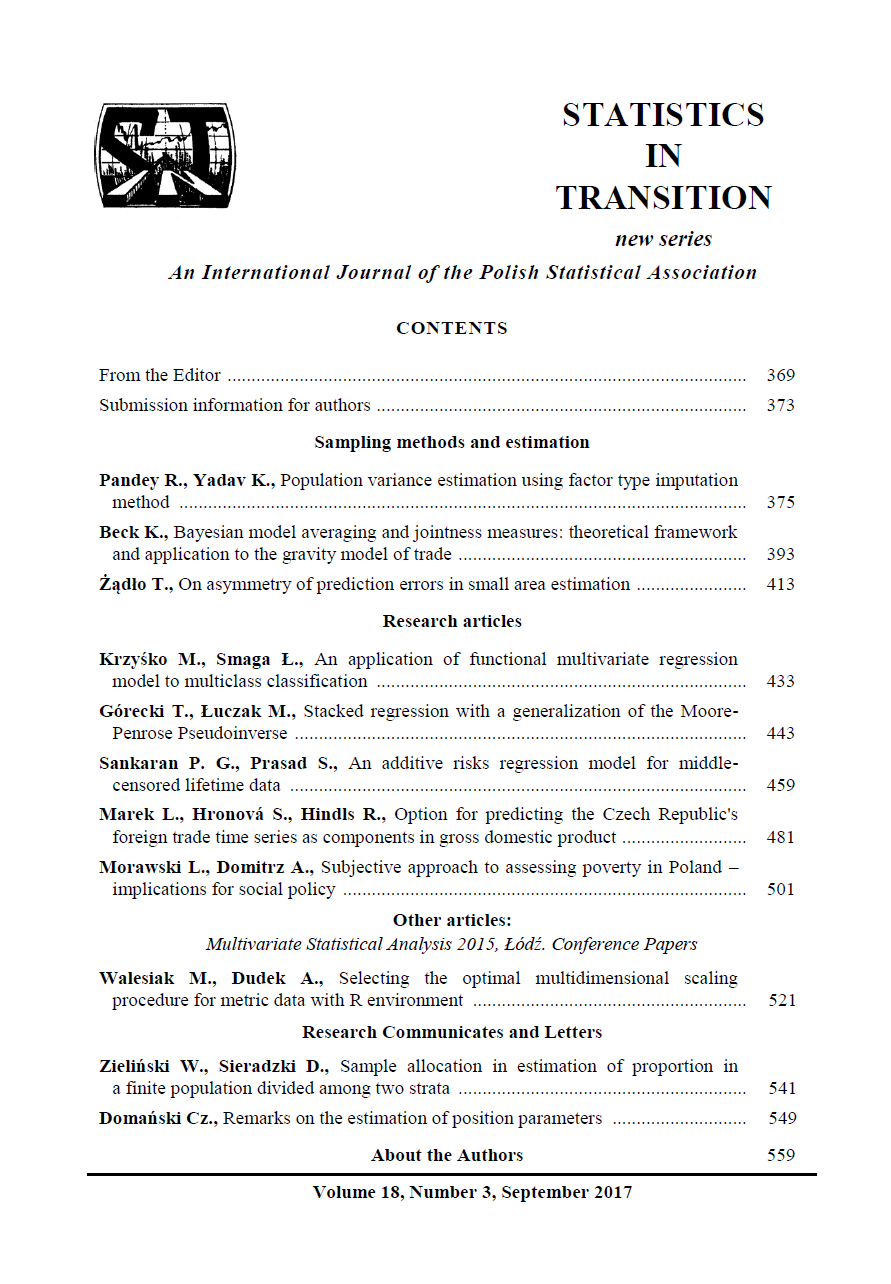ARTICLE
ABSTRACT
The mean squared error reflects only the average prediction accuracy while the distribution of squared prediction error is positively skewed. Hence, assessing or comparing accuracy based on the MSE (which is the mean of squared errors) is insufficient and even inadequate because we should be interested not only in the average but in the whole distribution of prediction errors. This is the reason why we propose to use different than MSE measures of prediction accuracy in small area estimation. In the prediction accuracy comparisons we take into account our proposal for the empirical best predictor, which is a generalization of the predictor presented by Molina and Rao (2010). The generalization results from the assumption of a longitudinal model and possible changes of the population and subpopulations in time.
KEYWORDS
empirical best predictor, prediction errors, small area estimation.
REFERENCES
BRACHA, CZ., (1996). Teoretyczne podstawy metody reprezentacyjnej, PWN, Warszawa.
DATTA, G. S., LAHIRI, P., (2000). A Unified Measure of Uncertainty of Estimated Best Linear Unbiased Predictors in Small Area Estimation Problems, Statistica Sinica, Vol. 10, pp. 613–627.
FABRIZI, E., TRIVISANO, C., (2010). Robust linear mixed models for Small Area Estimation, Journal of Statistical Planning and Inference, Vol. 140, pp. 433–443.
GONZÁLEZ-MANTEIGA, W., LOMBARDÍA, M.J., MOLINA, I., MORALES, D., SANTAMARÍA, L., (2007). Estimation of the mean squared error of predictors of small area linear parameters under a logistic mixed model, Computational Statistics and Data Analysis, Vol. 51, pp. 2720–2733.
GONZÁLEZ-MANTEIGA, W., LOMBARDÍA, M. J., MOLINA, I., MORALES, D., SANTAMARÍA, L., (2008). Bootstrap mean squared error of small-area EBLUP, Journal of Statistical Computation and Simulation, Vol. 78, 443–462.
JACQMIN-GADDA, H., SIBILLOT, S., PROUST, C., MOLINA J.-M., THIÉBAUT, R., (2007). Robustness of the Linear Mixed Model to Misspecified Error Distribution, Computational Statistics & Data Analysis, Vol. 51, pp. 5142–5154.
JIANG, J., (1996). REML Estimation: Asymptotic Behavior and Related Topics, The Annals of Statistics, Vol. 24, pp. 255–286.
KRZCIUK M., ŻĄDŁO T., (2014a). On some tests of variance components for linear mixed models, Studia Ekonomiczne, Vol. 189, pp. 77–85.
KRZCIUK M., ŻĄDŁO T., (2014b). On some tests of fixed effects for linear mixed models, Studia Ekonomiczne, Vol. 189, pp. 49–57.
MOLINA, I., RAO, J. N. K., (2010). Small Area Estimation of Poverty Indicators, The Canadian Journal of Statistics, Vol. 38, pp. 369–385.
NISSINEN, K., (2009). Small Area Estimation With Linear Mixed Models For Unit-Level Panel and Rotating Panel Data, University of Jyväskylä Printing House, Jyväskylä.
R CORE TEAM, (2016). R: A Language and Environment For Statistical Computing. R Foundation for Statistical Computing, Vienna, Austria.
ROYALL, R. M., (1976). The Linear Least Squares Prediction Approach to Two Stage Sampling, Journal of the American Statistical Association, Vol. 71, pp. 657–473.
STUKEL, D. M, RAO, J. N. K., (1999). On Small-Area Estimation Under Two Fold Nested Error Regression Models, Journal of Statistical Planning and Inference, Vol. 78, pp. 131–147.
ŻĄDŁO, T., (2013). On Parametric Bootstrap and Alternatives of MSE, Proceedings of 31st International Conference Mathematical Methods in Economics 2013, College of Polytechnics Jihlava, pp. 1081–1086.
ŻĄDŁO, T., (2015). Statystyka małych obszarów w badaniach ekonomicznych. Podejście modelowe i mieszane, Wydawnictwo Uniwersytetu Ekonomicznego w Katowicach.
